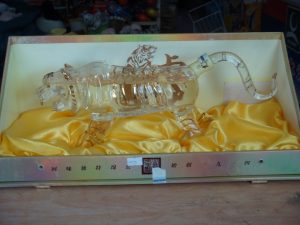Ongoing and clandestine tiger trade in China is no surprise to EIA – or the country’s Government
On 17 December, a UK newspaper ran a story with gruesome images depicting tiger killing and trade at a captive tiger facility, reportedly sourced from a whistleblower at the Qinhuangdao Wildlife Rescue Centre, in Hebei Province, China.
According to the story, the whistleblower had shared the pictures and information with one of China’s leading independent national non-government organisations which circulated it via social media.
If indeed the images are from Qinhuangdao Wildlife Rescue Centre, it would come as no surprise to EIA. This facility, which our investigators exposed in 2012 for its role in making tiger skin rugs, is adjacent to the Qinhuangdao Wild Animal Park, which we also exposed in 2007 for selling tiger bone wine.
These were not operating at the time as criminal enterprises, however; they were operating with the full complicity of the Government with permits to profit from tiger trade.
During our 2007 tiger bone wine investigation and our 2012 tiger skin trade investigation, we were shown paperwork and promotional material confirming what staff claimed – that Qinhuangdao Wild Animal Park had Government permission to make tiger bone wine from the bones of tigers that had died on the premises and the Qinhuangdao Wildlife Rescue Centre had Government permission to use the skins of tigers (and other endangered wildlife) from licensed zoos for taxidermy purposes.
The Qinhuangdao Wildlife Rescue Centre was established by the China Wildlife Conservation Association (CWCA), a national non-profit organisation affiliated to the then-State Forestry Administration (today known as the National Forestry and Grassland Administration, or NFGA).
In 2012, the then-manager of the Qinhuangdao Wildlife Rescue Centre/CWCA taxidermy workshop said that since the beginning of that year, the workshop had sourced and processed five tiger skins from zoos across the country.
He said that due to surging demand, he didn’t have any available for sale at the time of our visit and that tiger skins were quickly sold – “too popular to keep”.
He also added that all of the five skins processed that year were for “personal collections” and were made into tiger skin rugs, rather than taxidermy specimens for scientific and educational purposes. It did have a stuffed tiger cub and a leopard skin was being prepared for processing at the time of our visit.
This Government-supported commercial trade was highlighted in the Qinhuangdao Wildlife Rescue Centre promotional brochure, which states that “the use of taxidermy items as luxury home décor is an increasingly fashionable way to demonstrate higher status.”
Staff at the centre also said in relation to tiger skins that “once we get the skins, even before making them, they will all already be reserved … anyone can buy. There are so many wealthy guys, some can sell it again.”
EIA’s findings were shared with Government agencies in China and other Parties to the Convention on International Trade in Endangered Species (CITES) – by clearly supporting trade in captive-bred tiger parts, the Chinese Government was showing flagrant disregard for a 2007 CITES Decision to phase out tiger farms.
The Chinese Government did not respond specifically to our reports, but following persistent challenging through CITES it has subsequently confirmed that the skins of captive tigers can be traded. On the question of use of tiger bones, the Government did not deny that the bones of captive-bred tigers were being piloted for use in hospitals, but insisted the bones were not available commercially.
Fast-forward to 2018 when, following years of pressure from the owners of the 6,000 captive tigers across the country, China’s State Council repealed a 25-year ban on use of tiger bone in medicine. Government spokespersons backtracked a month later after an internal and international backlash and indicated the ban would remain in place, but instead of bringing in a clear and unambiguous prohibition on the use of all tiger parts and products, from wild and captive sources, the Government has left the situation open to interpretation.
The 2018 policy allowing use of captive-bred tiger bones is still listed on Government websites, while the country’s Wildlife Protection Law continues to allow use of protected wild animal species for production of traditional medicine and ornamental items.
If the images circulating are from Qinhuangdao, there is no way the Government can claim it did not know what was going on there; instead, it has allowed it to continue. How many tigers have been traded since our investigations in 2007 is anyone’s guess.
With the Government of China playing host to next year’s 15th Conference of the Parties to the Convention on Biological Diversity (CBD), EIA has been calling for amendments to China’s Wildlife Protection Law to unambiguously close the country’s domestic market for tigers and other threatened species.
We have been appealing for leadership from President Xi Jinping to end the trade in captive tiger parts, which is stimulating demand and putting Asia’s remaining wild tiger populations under greater strain.
The thousands of tigers in facilities such as Qinhuangdao serve no conservation purpose and cannot be released into the wild. The Government must commit to phasing out the keeping and breeding of tigers and destroy stockpiles of dead tiger parts and products so they don’t enter trade.
With the next Year of the Tiger in 2022 just around the corner, we urge the Chinese Government to demonstrate commitment to wild tiger conservation by amending legislation to prohibit any commercial use and invest in consumer behaviour change campaigns.







